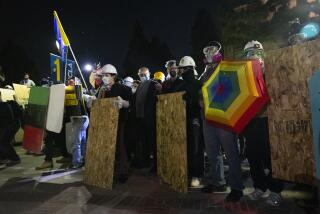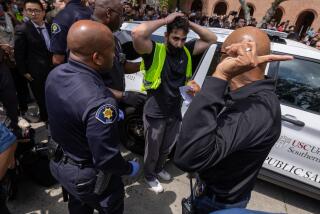Pool Reporting: There’s Good News and Bad News : Media: A look at the process reveals the difficulty of evaluating dispatches from the battlefield.
DHAHRAN, Saudi Arabia — They number 99, the combat pool reporters who bring to the world the action stories and pictures of American and coalition forces on the battle lines in the Persian Gulf.
About 700 war correspondents and photographers from around the globe have been given credentials by the military’s Joint Information Bureau. Most made their way to key Saudi cities before commercial air flights were suspended in the zone of conflict. Another planeload of American correspondents arrived here Friday aboard a Military Airlift Command C-141.
Of those with credentials, only a limited number--99 by one count on Saturday--are actually deployed with coalition combat soldiers, Marines, sailors and fliers. In itself, the number of journalists covering such a big event is small, roughly a third the size of the press contingent at a typical political convention or Summer Olympics.
In the language of news reporters, now becoming familiar to everyday Americans, these men and women serve as “pool” correspondents for all the news agencies covering the war. In this case, it refers to pooled effort and pooled results.
This is the most elaborate and sustained pool effort in modern U.S. military history. By contrast, in Vietnam--the last major conflict for the United States--journalists were allowed broad freedom of movement, independent of any official escort.
Many of the procedures in the Persian Gulf War, including the requirement that all press pools be escorted by a military public affairs professional, clearly reflect the military’s widespread belief that the free-ranging tone and vivid detail of Vietnam coverage contributed to the anti-war movement in the United States.
The pool concept during combat was established after the 1983 Grenada conflict in which the American press was kept from covering the event, instead getting their information from military reporters and camera crews.
In its first trial, during the 1989 invasion of Panama, the concept was criticized by the media because the press pool arrived after fighting had ended in one area and was barred from another, active combat area.
A look at the pool process--its limitations, early successes and frustrations in the Gulf War--could help Americans better understand their own difficulty in evaluating dispatches from the battlefield.
So far, correspondents seem of a mixed mind about the heavy hand of military control with the information in this war, with some results better than anticipated and some most assuredly not.
Veteran correspondents say the military has adequately positioned correspondents in most of the important locations--with the front-line Army and Marine troops in the desert, at the airfields and aboard key ships.
There have been some notable exceptions: There is very little known about the actions and airmen of the B-52 bombers, for instance. And when U.S. and Kuwaiti naval forces moved in on Iraqi antiaircraft batteries on oil platforms in the gulf Saturday, the military apparently used a ship that was not being covered by pool journalists. Pool reporters were brought in only after the operation was concluded.
But correspondents have had a crack at all kinds of other front-line units and weaponry, such as a squadron of the once super-secret F-117A Stealth fighters and a top-of-the-line Patriot anti-missile battery.
In small groups, the combat pool reporters--typically including crews from television and radio, still photographers and writers for magazines and newspapers--have had mostly open access to the fighting and support troops. And the stories from these men and women have been almost uniformly gung-ho, go-get-’em. Through them, particularly the jet pilots, Americans have sampled the fury of the war and the spunk of the warriors.
“I see fire in their eyes,” said an Air Force squadron commander in one pool dispatch describing the bravado of fliers after losing a comrade. Or this from a soldier in a chow line, reacting to news accounts of air combat success: “I woke up this morning with a smile on my face.”
But it has been a narrow sample, as if to say that the experiences of a garage mechanic in Des Moines and the viewpoint of a teacher in Covina explained life in America.
Pool dispatches also have been heavy with military-tech, although each picture and word is reviewed by censors. Correspondents and photographers said they have experienced some requests for deletions, but in all important cases--at least insofar as is known in these early days--only for matters that involved military concern about divulging classified locations and information.
As a condition for receiving credentials, reporters are forced to sign an agreement that they will adhere to military ground rules. One of the ground rules is that the ground rules cannot be divulged because they would identify to the Iraqis and terrorists the limits of what can be reported.
The shortcomings of the system are significant. Few pool reports contain so much as a whiff of command authority, a sense of the larger picture, the relative purpose of one action with another, and the strategic aftermath and its value to the war effort. If the war expands and ground troops clash in what is sure to be a bloody showdown on the sands of Kuwait and Iraq, such lapses in war dispatches could lead to a misunderstanding of the progress of battle.
Already many Americans have felt their moods about the war tugged one way and then another based on limited, sometimes anecdotal accounts while the generals who may have known better, or more, or different, remained mute or divulged little at their scheduled, stone-faced briefings in the rear and in Washington.
Pool reports have played only a part so far in this psychological roller coaster, with much of the journalism reaching America directly from Mideast correspondents at locations not under the control of the military. But pool accounts are likely to grow in significance in a ground campaign to regain Kuwait.
The pool system, perhaps without many Americans being aware, also has proven weakest in the very area where the news media have otherwise been strongest--in the swiftness of the reporting.
The Gulf War is the instant war, with CNN in particular blazing a trail where even policy-makers, government leaders and other journalists tune in for “the latest.” But pool reports from combat units have been anything but instant for CNN, the Los Angeles Times and everyone else reporting on the war.
Many hours, sometimes two days, pass between the time pool reporters finish their dispatch and the moment when they reach the Eastern Saudi Arabia Joint Information Bureau and are distributed to other reporters to be relayed home. The result is that pool reports often lack any sense of freshness or urgency, despite the understandable inclinations of correspondents to de-emphasize this.
The opening attack on Baghdad was reported by those on the ground in Iraq a full day before the bulk of pool reports--about the air crews, what they saw, felt and did--were distributed at press headquarters here. By then, the interest of many Americans already had shifted to surface-to-surface missile attacks on Israel from western Iraq and the capture of Iraqi POWs.
At a briefing before the conflict began, veteran journalists told newcomers what to expect. Forget the little portable computers and high-tech equipment on which newspaper stories are written today. Correspondents were advised to buy every old-fashioned portable typewriter in Eastern Saudi Arabia.
Some reporters found themselves using carbon paper for the first time in their careers. Four copies were advised, one for the official military courier and the others as backups to be sent to the rear areas any way possible--on supply planes, passing truck drivers and so forth. Despite military promises to make delivery of pool dispatches a priority, some journalists wonder if the system can withstand the logistical strain when ground troops engage and the number of combatants in the region soars from a few hundred pilots to tens of thousands of soldiers.
For their part, military officials have also expressed mixed feelings about the success of the news reporting from the war front to date. “Quite frankly, there is a lot of circular reporting that comes up in the media . . . speculative reporting,” said Marine Corps Maj. Gen. Robert Johnston, answering questions on Saturday.
All of this has occurred as the progress of the war has been favorable for the U.S.-led coalition. The question of what will happen to pool reporting if the Iraqis have things their way on the battlefield has not, of course, been tested. Military officials insist there will be no change to protect troops or their commanders from criticism or embarrassment. In fact, military liaison officers are specifically forbidden from using their censorship powers to protect the image of the armed forces.
Worriers note, though, that access to Stealth fighter units, including permission to photograph the airplane close-up and interview pilots, was allowed only after the futuristic fighter-bomber proved itself in combat. At that, it was not problem-free.
“Even after the file was censored here, it was held up by the Pentagon and never reached Dhahran,” New York Times pool reporter Malcolm W. Browne wrote in a note explaining the fate of one of his dispatches about the F-117A.
For those correspondents who remain at press headquarters in Dhahran or to the southwest at Riyadh, awaiting duty in the combat pools, the war is too far off to allow compelling reportage. But not so far as to eliminate concern about the future of one’s own hide.
Anyone who ever had a grudge against the press could take satisfaction in the scene in the basement of a major press hotel on the second night of the war. Scores of reporters donned their gas masks after an air raid and the sighting of a U.S. anti-missile firing. Sitting on the floor, journalists listened to a far-off broadcast report of nerve gas having been put into play in the combat theater. Every soul in the room wondered if the gas was headed in his or her direction.
It was not, as events turned out. But still, said a Detroit newspaper reporter, “it was torture.”
More to Read
Sign up for Essential California
The most important California stories and recommendations in your inbox every morning.
You may occasionally receive promotional content from the Los Angeles Times.










